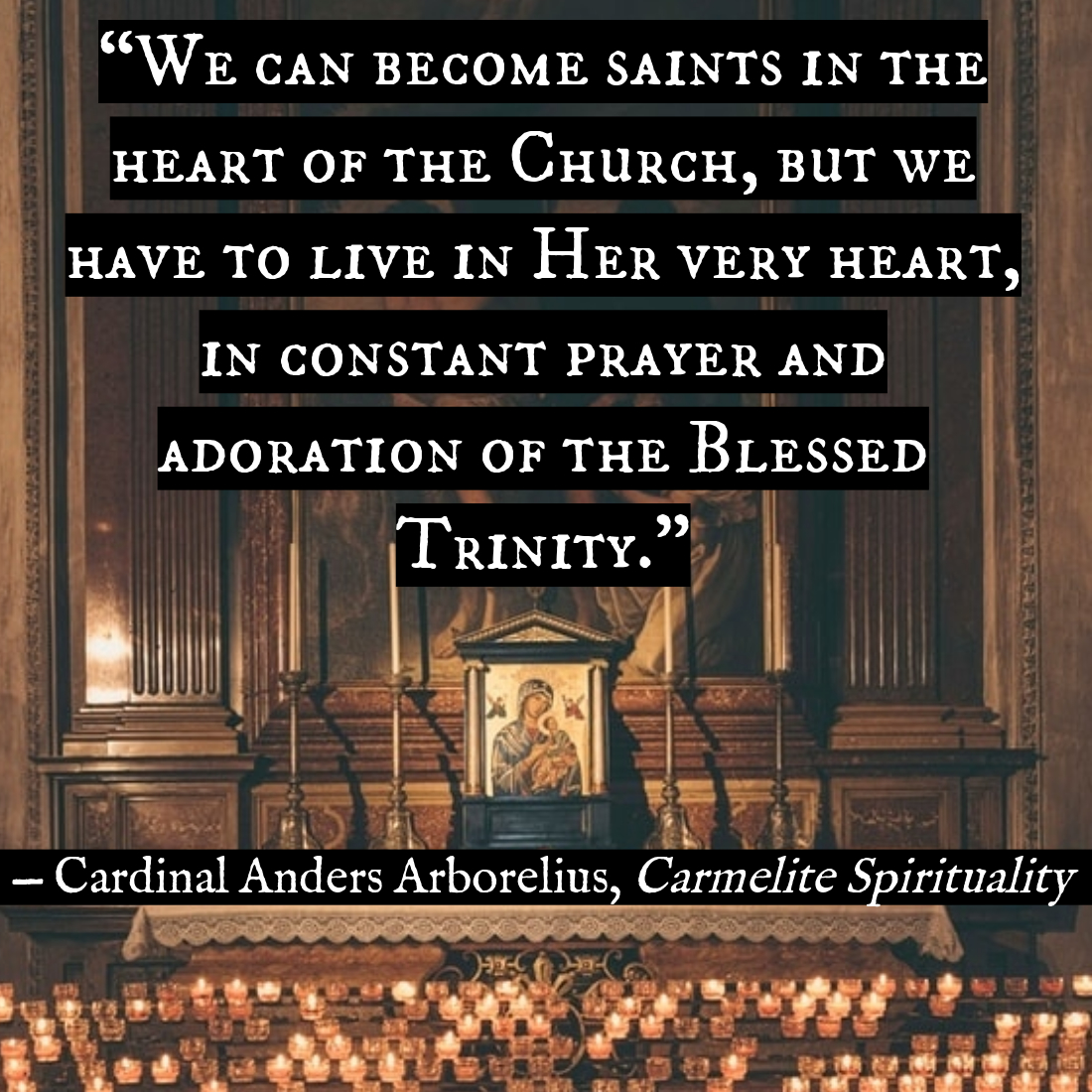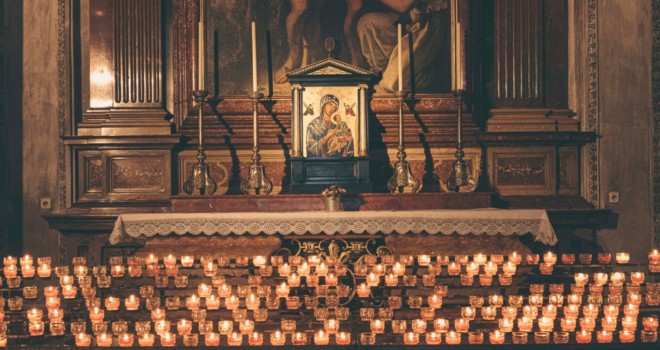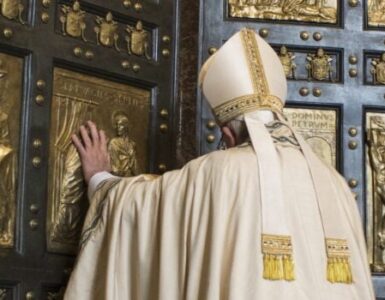As her name indicates, St. Elizabeth of the Trinity was totally immersed in contemplation of the triune God Who lived in her through Baptism. She knew that the ultimate foundation of human love and friendship is always the unity of love reigning within the Trinity. As a reflection of God Himself, the friendship between human beings becomes a redemptive reality in the Church. The Church is the context, the atmosphere, where we live in a kind of Trinitarian friendship. God is always present among the members of the Church, binding them together just as the three Divine Persons are bound together.

Elizabeth described her friendship with another sister, “The mystery of the Three has been reproduced on earth since our two hearts have found their union in Yours.” The Church is the communion of saints in which the Most Holy Trinity is always present as the heart of the ecclesial mystery. The Church always reflects the Trinity, and inter-ecclesial solidarity has its foundation in intra-trinitarian communion. This majestic truth of our Faith becomes a day-to-day reality in the life of Carmel, where Elizabeth tried to live in constant union with the Trinity, and at the same time, with her sisters.
Although she lived totally hidden away from the outside world, it is quite evident through her many letters that she had friendly relationships with many people outside Carmel. These letters are often masterpieces of concrete spiritual direction for laypeople. Her spiritual doctrine is very much suited for people living in the midst of society. And in this way, her ecclesial mission becomes evident. She was aware that all the members of the Church, whether in peaceful enclosures or busy in society, are united in adoration of the Trinity, helping each other in the fulfillment of this important task. Through adoration, they become brothers and sisters in the communion of saints. In the act of adoration, they enter into an invisible unity with each other, and this day-to-day reality brings forth many hidden fruits.
This vision of spiritual solidarity emphasized by Elizabeth can be very helpful for so many people feeling isolated and alone, suffering from this twofold disease that is, alas, so common today. If people came to the realization that they really belong to this communion of saints, things would change dramatically.
Elizabeth made a spiritual synthesis that reflects her vision of her own vocation. She uses the Latin words laudem gloria, from St. Paul, in order to characterize this vocation of hers. She is “called to give praise and glory to God whatever she is doing, however she is feeling.” Here on earth, Elizabeth had already begun doing what she was meant to do in eternity — glorify God. She knew that she was never on her own, but always united with all believers, on earth, in Heaven, and in Purgatory.

The Church is one and the same in its different stages. As Bride of the Lamb, She is always adoring and glorifying the Most Holy Trinity. With the simple eyes of faith, Elizabeth contemplates the entire mystery of the Church, which has its beginning in the bosom of the Trinity long before the creation of the world and which one day will find its fulfillment there, too.
In Elizabeth’s writings, the notion of predestination is quite common. We might even say that Elizabeth is the Catholic answer to Calvin. In contrast to his individualistic outlook, she looks upon predestination mainly as the predestination of the entire ecclesial body to take part in God’s eternal glory. Every person is called upon to enter into communion with the Church, being transformed by grace and finally receiving eternal glory through the merits of the redemptive love of Christ. Predestination is a mystery of immense love.
In a posthumous note, Elizabeth of the Trinity wrote, “I bequeath to you this vocation which was mine in the bosom of the Church Militant and which I shall fulfill henceforth unceasingly in the Church Triumphant: a praise of glory of the Blessed Trinity.” This spiritual heritage of hers is a very pedagogical, or rather mystagogical, approach to the entire reality of the Church. We can never separate the Church from the Trinity. In her bosom, we can live as friends adoring God, giving praise to Him and, thus, growing in mutual love and help. This intra-ecclesial friendship is also an important point of evangelization, as we know from the early Church. “Friendship with any man is ultimately friendship with Christ,” William Johnston said.
Mother and Bride
The Church is more Mother than institution, more Bride than hierarchy, more mystery than sociology. The Carmelite vision of the Church concentrates on this innermost reality of the Church. This reality can help those who often feel utterly alone and empty, to find healing in the life-giving womb of the Church.
Jesus will always care for His bride, whether she be the Church or the soul. Human beings are always the same. They were created by God’s love and for His love. If they can discover the Church as the fruitful ambiance where they can inhale God’s love and be transformed by it, then they will feel at home in Her. The Carmelite saints have an extraordinary capacity to point to essentials. When they speak about the Church, they always do so in a tone of prayer and adoration of the triune God. The Church is a reflection of the intra-trinitarian love between the divine Persons.
Consequently, the Church will always bring us closer to God. The Carmelite mystics can help our brothers and sisters who are formed and shaped by the modern malaise of individualism to rediscover the true face of the Church.
The Carmelite doctrine stressing these theological virtues is a remedy against this disease of our times. The Church is the concrete brotherhood — and sisterhood — in which we help each other to live according to the theological virtues. The Carmelite saints are our helpful brothers and sisters on this mystical path. The contemplative ecclesiology of Carmel can also be a remedy against the malaise that so many of our contemporaries feel in regard to the Church and Her many weaknesses.
In her notes from 1932, Edith Stein wrote,
“The Church as the Kingdom of God in this world should reflect changes in human thought. Only by accepting each age as it is and treating it according to its singular nature can the Church bring eternal truth and life to temporality.”
With these words, Edith Stein indicates the responsibility of the Church. The Church must listen with a contemplative ear to every age and every movement in time. She is a part of the world and so must have solidarity with it. She must be able to see what is happening in human hearts in every single moment of human history. God also speaks to Her through the world. Carmelite mysticism helps us to be listeners to God in Himself but, also, to God speaking to us through the hidden signs in humanity and creation at large. “Creatures are like a trace of God’s passing. Through them, one can discover His grandeur, might, wisdom, and other divine attributes,” says St. John of the Cross.
The Church of today needs a kind of spiritual plastic surgery in order to rediscover Her true heart and regain the true beauty of Her face. Our Carmelite tradition can help her in this ongoing process of conversion, in order that She may realize that, through Her wounds, She is even closer to her Bridegroom and His redemptive love. “His heart is an open wound with love,” St. John of the Cross said. And so we, too, in our lives in the Church can receive Christ’s redemptive love. We can live in His presence. We can receive His grace. And we can become more and more the Church as it is meant to be, because as we see in the Carmelite mystical tradition, the Bride of Christ is the Church, it is Mary, and it’s each one of us. And within the Church we receive our true being. We can become saints in the heart of the Church, but we have to live in Her very heart, in constant prayer and adoration of the Blessed Trinity.
✠
This article is adapted from a chapter in Cardinal Arborelius’s book, Carmelite Spirituality: The Way of Carmelite Prayer and Contemplation. It is available as an ebook or paperback from your favorite bookstore or online through Sophia Institute Press.
Photo by who?du!nelson on Unsplash














